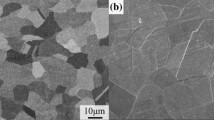Abstract
The anodic oxidation behaviour of Al–Ti alloys in several acidic solutions was investigated. The influence of conditions such as alloy composition, electrolytic solution, electrolyte temperature and formation current density on the formation rate of oxides on Al–Ti alloys and the dielectric properties of the anodic films were analysed. It was shown that the oxide formation rate for the Al–Ti alloy containing 54 at % aluminium was the highest and the dielectric property of its anodic oxide was also the best. In addition, by means of several surface analytical techniques, the chemical composition of the films were determined as (TiO2) n (Al2O3) m . AES (Auger electron spectroscopy) profiling analysis data showed that Al–Ti alloys had preferential oxidation behaviour, that is, the aluminium was oxidized preferentially.
Similar content being viewed by others
References
H. Igarashi, S. Shimizu and Y. Kubo, IEEE Trans. Compn. Hybrids & Manufacturing Techn., CHM16(4) (1983) 363.
S. Shimizu and Y. Arai, European patent 84/102 880 (1984).
T. Mochizuki, Japanese patent 88 306 614 (1988).
A.N. Kamkin, A.D. Davydov, Prot. Met. 35 (1999) 134.
Y. Li, H. Shimada, M. Sakairi, K. Shigyo, H. Takahashi and M. Seo, J. Electrochem. Soc. 144 (1997) 866.
G.M. Treacy, A.L. Rudd and C.B. Breslin, J. Appl. Electrochem. 30 (2000) 675.
H. Wu, X. Zhang and K.R. Hebert, J. Electrochem. Soc. 147 (2000) 2126.
G.E. Thompson and G.C. Wood, Anodic Films on Aluminium, in J.C. Scully (Ed.), 'Treatise on Materials Science and Technology', Vol. 23 (Academic Press, New York, 1983), p. 229.
N. Cabrera and N.F. Mott, Rep. Prog. Phys. 12 (1948) 163.
G.E. Thompson, R.C. Furneaux, G.C. Wood, J.A. Richardson and J.S. Goode, Nature 274 (1978) 433.
R. Coelho, 'Physics of Dielectrics' (Elsevier Scientific, Amsterdam, 1979).
Li Di, 'Principles of Electrochemistry' (Beijing Aviation University Press, Beijing, 1999).
A. Despic and V.P. Parkhutik, Electrochemistry of aluminium in aqueous solutions and physics of its anodic oxide, in J.O. Bockris, R.E. White and B.E. Conway (Eds), 'Modern Aspects of Electrochemistry', Vol. 20 (Plenum, New York, 1989), p. 449.
R. Kelly and N.Q. Lam, Redat. Eff. 19 (1973) 39.
R.C. Weast (Ed.), 'Handbook of Chemistry and Physics', 66th edition (CRC Press, Boca Raton, FL, 1985–1986) F164.
H. Habazaki, K. Shimizu, P. Skeldon, G.E. Thompson, G.C. Wood and X. Zhou, Corros. Sci. 39 (1997) 731.
Author information
Authors and Affiliations
Rights and permissions
About this article
Cite this article
Song, Y., Zhu, X., Wang, X. et al. Anodic oxidation behaviour of Al–Ti alloys in acidic media. Journal of Applied Electrochemistry 31, 1273–1279 (2001). https://doi.org/10.1023/A:1012746926209
Issue Date:
DOI: https://doi.org/10.1023/A:1012746926209




